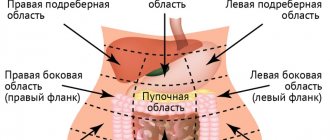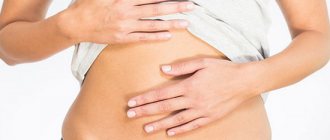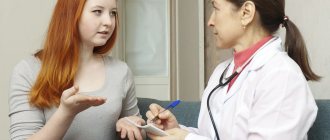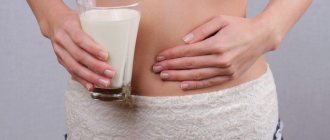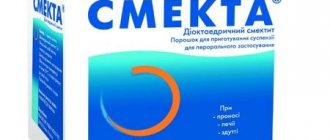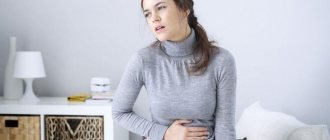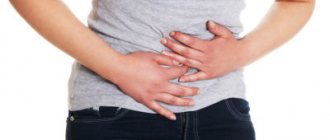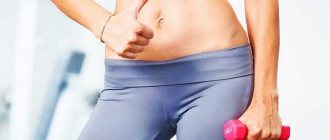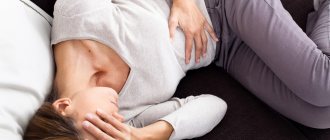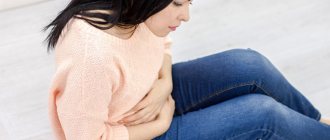- November 23, 2018
- Other states
- Matela Victoria
What to do if you have severe pain in the intestines on the left side? If you experience pain in the intestines, it is important to immediately seek help from a specialist, since such a symptom may indicate that a serious illness is developing. After a thorough diagnosis of the patient, the doctor will be able to identify the factor that provoked the unpleasant sensation. Based on the diagnostic results obtained, the specialist will make a diagnosis and prescribe comprehensive treatment. Painful sensations in the abdomen can occur at any age and at any time. To know what to do correctly in such a situation, it is important to familiarize yourself with the main features of such a pain syndrome.
Determining the presence or absence of disease
During the development of what disease does pain occur in the intestines on the left side? In order to determine the disease that provokes the occurrence of painful sensations, you need to listen to your body and analyze the main symptoms that cause discomfort:
- With chronic diseases of the gastrointestinal tract, cancer, intestinal obstruction or volvulus, pancreatitis, the intestines hurt greatly.
- Colic occurs due to spasms, intoxication, the introduction of pathological microorganisms into the body, or due to mechanical damage to the intestines.
- With ulcerative colitis, appendicitis, and infectious diseases of the gastrointestinal tract, acute, recurring pain develops in the intestines on the left side.
- Due to intestinal irritation, prolonged cutting pain develops in the lower abdomen.
- With gastritis or inflammation of the esophageal mucosa, the patient is bothered by pressing or bursting pain in the intestines.
If severe pain occurs in the intestines, it is important to determine the location of the unpleasant symptom. The pain can be felt on the right and left, near the ilium, closer to the navel, or radiate to the entire abdomen:
- Colic is a common cause of left intestinal pain. If the pain is localized in the lower abdomen or in the navel area, then we can say that the patient has enteritis, colic or worms.
- With appendicitis and diseases of the colon, discomfort occurs in the right iliac region.
- With dysentery and sigmoid colon disease, the pain is localized on the left side of the iliac region.
If the intestines hurt on the right and left, this indicates that the inflammatory process affects several segments of the intestine or a duodenal ulcer develops. Under such conditions, self-medication is prohibited. Only a doctor should prescribe medications. The dose and duration of treatment is determined by the doctor.
Main causes of pain
Pain in the left hypochondrium may indicate a disease of the spleen.
Unpleasant sensations occur in the left hypochondrium if the following organs have been negatively affected:
- left side of the stomach;
- intestinal loop;
- kidney on the left;
- ureters;
- spleen;
- pancreas;
- left side of the diaphragm.
If the pathology affects any of the above organs, dull pain appears and there is aching in the side. Periodically occurring unpleasant sensations indicate a developing disease. And if the pain becomes constant, it means the disease has become chronic. The digestive organs may cause pain after eating or, conversely, during prolonged hunger.
Since any painful sensations are a reflection of the ability of organs and systems to transmit signals about the emerging pathology to the brain, such a warning should not be ignored. The human body is considered a harmoniously built system.
Therefore, nothing can simply happen by chance. A permissive attitude towards your body and the desire to self-medicate rarely have a positive result. In most cases, there is a sharp deterioration in the condition, which can even lead to death. The most reasonable thing is to seek advice from a specialist.
When going to the clinic, you need to prepare a complete description of the nature of the pain. The most accurate information will help you make a correct diagnosis. You need to know the following:
- where exactly does it hurt;
- how often does pain occur;
- what causes their occurrence, is it possible to establish a connection with food intake;
- what is the nature of the pain: sharp or aching.
Read: A newborn has a stomach ache, what to do, how to help and how it can be dangerous
Pain in the left hypochondrium is not always associated with a disease of the digestive system. This may be a manifestation of pathology of the circulatory system. Failures in the supply of oxygen to organs lead to their depletion, as a result, nerve endings undergo the same processes, which results in pain.
Disturbances in the outflow of fluid, leading to edema, are also the cause of pain in the left hypochondrium.
How to detect the presence of a pathological process?
If the patient’s general well-being has significantly deteriorated and pain systematically occurs in the intestines on the left side, you should consult a doctor, as this may indicate that a serious pathology is developing. You should immediately contact a specialist if:
- The patient's body temperature has risen.
- Having problems with bowel movements.
- Very nauseating.
- There was profuse vomiting.
- Excessive gas production and flatulence.
- The presence of blood or mucous discharge in the stool.
- Severe pain in the abdomen, on the left.
- Severe heartburn developed.
If any of the symptoms appear, it is important to consult a doctor immediately as serious health problems may arise. Self-medication is not recommended. The use of medicines and folk remedies other than as prescribed by a doctor often provokes the development of the disease.
Nagging pain in the left lower abdomen in women
The main sign of reproductive system problems in women is a nagging pain in the left lower abdomen. Pain in this area indicates problems with the left ovary. If you feel a nagging, burning pain that intensifies with prolonged walking, this indicates an inflammatory process that requires immediate attention to the gynecology department. Pain in the pelvic area in women can also be caused by the following ailments:
- Adnexitis . Sharp pain in the left side is caused by inflammation of the fallopian tube. If, in addition to severe pain, you also experience increased temperature, chills, urination problems, and tension in the muscles of the lower abdomen, then an urgent visit to the hospital is necessary. Untimely detection of adnexitis leads to the cessation of ovulation and the appearance of infertility.
- Cyst rupture . When benign formations on the ovaries rupture, piercing, severe pain, weakness, loss of consciousness, bleeding, nausea, and vomiting occur. Such symptoms require immediate hospitalization and surgical intervention.
- Oncology . Cancers of the ovaries or uterus may cause tenderness in the lower abdomen. The pathology was operated on in a timely manner, and successful results after undergoing radiation therapy give the patient a great chance of returning to a normal lifestyle. If cancer is diagnosed at the last stage, then death is possible.
- How to cure psoriasis of the scalp with shampoos, ointments and folk remedies
- Beef basturma at home - recipes with photos. How to make dry-dried beef in Armenian style
- Nutrition for hypertension and obesity
Signs
In addition to painful sensations in the stomach, other symptoms may occur that will help identify the disease:
- With gastritis, the patient experiences nausea, heartburn, burning sensation, drowsiness and increased fatigue.
- With appendicitis and peritonitis, body temperature rises significantly, appetite worsens, diarrhea and problems with emptying the bladder and intestines occur.
- If the patient has intestinal colic, constipation or pale gums may occur.
- Intestinal obstruction is accompanied by bloating, nausea, disruption of the cardiovascular system and dry mouth.
- With pancreatitis, vomiting, nausea, constipation, and flatulence occur.
- As enteritis develops, diarrhea occurs and cramps appear. A light coating may appear on the tongue.
- With helminthiasis, the patient experiences the following symptoms: nausea, pallor, lack of appetite, flatulence, itching in the perineum.
If one of the symptoms appears, it is important to consult a doctor, since self-medication can provoke the development of serious complications. Only after laboratory and instrumental examination can the causes of left intestinal pain be accurately identified.
What research methods does the doctor use to identify the disease that provokes pain in the intestines? The doctor evaluates the symptoms that have appeared in the patient, interviews the patient, finds out the nature of the discomfort in the intestines, and determines the presence of concomitant symptoms and chronic diseases. During the examination, the doctor palpates the abdomen and examines the lymph nodes, and gives a referral for examination. After receiving the results of coprogram, stool culture, fibrogastroduodenoscopy, colonoscopy and irrigoscopy, he evaluates the obtained indicators and makes a diagnosis.
Nature of pain
Stomach diseases can provoke acute pain in the left hypochondrium.
In order to orient yourself in the features of the pathology that has affected the body, you need to understand what the nature of the pain is.
Experts distinguish between sharp and dull pain, stabbing and cutting, dull and burning pain. All these varieties will indicate special processes taking place inside a person.
In the left side, with various pathologies, all the named varieties are observed. By determining their character, you can understand what kind of doctor you need. It is important to pay attention to the area where pain is more pronounced. This can be the anterior abdominal wall or the back, the side of the body.
Stitching pains
The safest type of pain. Sometimes they occur after intense physical activity in completely healthy people.
After a long or too fast run, after sudden jumps or exercise in the gym, this type of pain is observed if the body receives excessive stress. This condition may indicate a frivolous attitude towards warming up, when a person puts a powerful load on an unprepared body.
If the pain is caused solely by physical exercise, the condition quickly returns to normal after stopping the exercise. If pain is also felt in the back, this should also not cause concern. After all, such a state is usually characteristic of situations when a sharp, inaccurate movement is made that is not characteristic of the human body.
The reason for the appearance of colic when unprepared for physical activity is explained by too rapid an increase in blood flow and the inability of the internal organs to perceive this. A 20-30 minute warm-up is a mandatory requirement for the preparatory part.
Read: Cleaning the intestines at home: various methods - both modern and traditional
Only after a good warm-up can you proceed to the main part. Moreover, if men can shorten this time period, then this is extremely harmful for women. Their body requires longer preparation for stress.
You will learn about the causes of pain in the left hypochondrium from the video:
Rezi
Cutting pains are truly dangerous. If severe pain suddenly appears, hospitalization is required. If this occurs after physical activity, you don’t have to worry too much. But cramps at rest signal a dangerous condition.
Pain that is stabbing in nature is most often the result of a violation of the integrity of the listed internal organs.
This pathology most often affects the spleen, renal pelvis, intestinal loop, and stomach wall.
Acute pain
If acute pain appears after an injury, the victim must be urgently taken to the hospital. If he feels sharp pain when inhaling or exhaling, this may indicate damage to internal organs. In this case, failure to provide timely assistance will simply lead to death.
Dull pain
With gastritis, the patient feels dull pain in the abdominal area.
Dull pain in the left hypochondrium may occur with some frequency or even constantly. In any case, this is a signal of a chronic disease that is taking over the body.
Gastritis, cholecystitis, pancreatitis, and many other diseases give such a reaction. To fight a developing disease, you need to seek help from a gastroenterologist, take all the tests he prescribes, and undergo examinations.
Aching pain
This nature of pain also helps to make a specific diagnosis. In most cases, duodenitis and colitis give this picture. But aggravating the situation with nausea and vomiting is already a sign of ulcerative lesions.
If, after complaining of such pain, an examination shows the absence of pathology in the digestive organs, then you need to rush to a cardiologist. After all, it is coronary heart disease, angina pectoris and even a pre-infarction condition that are considered the main causes of this disease. We must remember that the following diseases can cause pain in the left hypochondrium:
- heart attack, other diseases of the cardiovascular system;
- intercostal neuralgia;
- diseases of the gastrointestinal tract;
- diseases or injuries of the spleen;
- new developments in this area;
- diaphragm injuries, hernias;
- rheumatism;
- diseases of the respiratory system on the left side, for example, left-sided pneumonia or pleurisy.
Read: Abdominal cramps: causes and treatment
What to do if there is severe pain in the intestines?
The left intestine hurts. What to do? Under such conditions, it is important not to self-medicate. You should call an ambulance if:
- pain in the intestines is accompanied by fever and profuse vomiting;
- the urine has darkened significantly;
- the color of the skin has changed;
- there was acute pain in the abdomen, which radiates to the lower limbs and pelvis;
- severe abdominal pain after injury;
- there was bleeding from the anus;
- vomiting blood;
- dizziness occurred;
- the intestines on the left under the ribs hurt.
It is not recommended to take medications without a doctor’s prescription, since self-medication can aggravate the course of the disease.
What does stabbing pain in the left side mean?
The intensity of painful sensations and their duration may indicate the presence of serious diseases that must be immediately identified and effective treatment begun. Pain in the left side indicates the onset of acute, chronic diseases. Such pain is localized under the rib, on the back, in the lumbar region, in the heart and can intensify after eating. Accurate determination of the location of the pain helps to accurately determine which organ is signaling its pathology.
Behind under the rib
There are many reasons for pain in the back of the diaphragm, under the rib. If you experience constant pain, you should visit a general practitioner to rule out serious pathologies. Pain in the left side of the posterior hypochondrium indicates the development of the following ailments:
- Heart diseases . Paroxysmal, dull pain is characteristic of angina, pericarditis, and aortic aneurysm. Timely detection of pathology using ultrasound or electrocardiography will help prevent the development of heart disease.
- Intercostal neuralgia . Acute, piercing pain occurs when the intercostal nerves are pinched. Additionally, excessive sweating and redness of the skin are observed. The pain intensifies with sneezing or sudden movement, which does not go away day or night.
From the back
With the development of inflammation in the left lung, the patient experiences nagging, dull pain that becomes stabbing in nature when coughing. Also at the initial stage of pneumonia, muscle soreness, sore throat, weakness, and fever occur. If, in addition to these symptoms, shortness of breath, a bluish complexion, and swelling of the veins on the top of the neck are observed, then left-sided pleurisy is diagnosed.
In the lumbar region
Lower back pain may indicate the presence of pathology of the left kidney. By the pain in this place, one can determine the development of pyelonephritis, the appearance of which is provoked by bacterial infections. Additionally, chills, nausea, fever, weakness, and vomiting are observed. If stones or sand have formed in the organs of the urinary system, then a sharp girdle pain is felt when walking, exercising or driving for a long time. With such symptoms, the doctor diagnoses urolithiasis, which begins on the left and then completely encircles.
Hearts
Pain under the heart can be caused by diseases of the organ itself. Pain moving to the left arm and neck, which is accompanied by vomiting, shortness of breath, increased sweating, and dizziness, indicates myocardial infarction. With this diagnosis, urgent hospitalization of the patient is necessary. First, doctors will conduct an examination, and then take emergency measures to save the patient’s life.
Pathologies of the heart vessels, valves, and arteries are also accompanied by pain on the left side under the heart. If the patient additionally experiences a rapid pulse and fatigue, the doctor will diagnose cardiomyopathy. When the specialist determined that there was a violation of the blood supply to the heart muscle, the pain in the left side was caused by coronary heart disease.
After meal
If pain in the left side is observed after eating, then the symptoms that occur after eating indicate disorders of the gastrointestinal tract. Unpleasant tingling, heaviness, fever, chills, nausea, flatulence indicate the development of gastritis. When diagnosing such inflammation of the gastric mucosa, the doctor prescribes a diet and special medications. Pain after eating may also indicate the development of the following diseases:
- Pancreatic dysfunction . Problems with the pancreas begin with pain in the upper chest after eating. Inflammation of this organ leads to the development of pancreatitis, which leads to digestive disorders. The patient also experiences bitterness in the mouth and constant belching. To prevent this disease, it is necessary to avoid the consumption of alcohol, fatty, spicy, salty foods.
- Problems with the spleen . If a dull pain after eating is felt in the upper abdomen, then pathologies of the spleen are possible. Its close location to the abdominal cavity, the presence of infection, trauma negatively affects the consistency of the organ or an increase in its size.
- Appendicitis . If after eating the left side begins to hurt periodically or, conversely, there is a sharp, severe pain near the navel, then there is a suspicion of appendicitis. The pain does not stop, but intensifies when bending, walking, or inhaling. If these symptoms occur, you must call an ambulance.
- Intestinal diseases . Pain in the intestines is accompanied by rumbling, bloating, frequent urge to go to the toilet, and diarrhea. These symptoms are typical when inflammation of the large intestine occurs. Find out which diarrhea pills really work.
How to help yourself at home?
If the patient experiences severe pain that cannot be tolerated, the following medications can be taken (but after consulting a doctor, so as not to blur the symptoms):
- With the help of "No-shpa" you can eliminate spasms and dilate blood vessels. Thanks to the tablets, spasms and colic will be eliminated.
- "Spazmalgon" will eliminate pain in the large intestine, on the left and the inflammatory process.
- If you are constipated, you can take a laxative.
- Thanks to activated carbon, Enterosgel and Smecta, you can improve the functioning of the gastrointestinal tract and eliminate diarrhea.
For pain of an infectious nature, it is necessary to treat with antibiotics. Doctors prescribe prebiotics if the microflora is disturbed and pain appears in the intestinal area on the left.
Features of pain localization
Disease of the pancreas provokes pain in the torso in a circle.
When analyzing the location of pain, the mechanism of its occurrence is also considered. Based on this criterion, the following varieties can be distinguished:
- Reflected. These include all pain that occurs in organs located in completely different places in the body. Since they are radiating in nature, discomfort arises here. Such cases include myocardial infarction.
- Visceral. They cause disruptions in the functioning of the digestive organs: intestines, stomach. For example, banal flatulence can cause pain in the left hypochondrium.
- Peritoneal. These constant pains, which simply cannot be forgotten, are intensified after movements and deep breathing. They arise due to irritation of the peritoneum.
The affected organs are determined by the location of pain:
- The anterior part of the left side is the spleen, the walls of the stomach.
- The central part is the duodenum, gall bladder and, possibly, the same spleen.
- The back part (from the back) is the kidney. This may also be a sign of osteochondrosis of the lumbar or thoracic region.
- The torso hurts in a circle - shingles syndrome - the pancreas is affected. With pancreatitis, the pain is simply unbearable; if you do not seek medical help in time, shock from the pain syndrome may occur, and this does not always end in normalization of the situation.
Thus, any pain in the right hypochondrium cannot be ignored unless it appears as a result of serious physical activity.
True, even if pain occurs after playing sports, it is necessary to exclude injuries, the result of falls, which can lead to disruption of the integrity of internal organs. If pain occurs at rest, it always indicates a pathology of certain organs. Therefore, it is necessary to examine, identify their cause and treat.
Read along with this article:
- What is in a person’s left side and what can hurt there?
- Where is the pancreas located in a person and what are its functions...
- Pain in the rectum: causes of discomfort
- Spleen diseases: symptoms and causes
- Why does pain occur in the anus?
- Pain under the left rib in the front: causes, symptoms and methods...
- Right side hurts, what could it be and how to deal with it
- Severe pain in the left side of the lower abdomen: what may bother you
- Why does my right side hurt after eating?
Doctors' recommendations
To prevent the development of painful sensations, it is important to eat properly and not eat fried, smoked, pickled, or salty foods. Eat small meals often and drink enough water per day. Do not abuse drinks that contain large amounts of caffeine. Include fiber-rich vegetables in your diet. If pain in the intestines occurs due to poor nutrition, atony, or a sedentary lifestyle, it is recommended to perform daily exercises. Thanks to the systematic implementation of the complex, intestinal motility can be normalized. It is recommended to perform exercises in the first half of the day.
Physiotherapy
Lying on your back, we imitate riding a bicycle - about 3 minutes. Lie on your back, raise your straightened legs and place them behind your head - perform 5 approaches. Lying on your back, bend and straighten your legs - 10 approaches. When finishing the complex, you need to walk in one place, raising your knees high, for 2 minutes.
Only after a thorough medical examination can you perform gymnastics, since the doctor must determine whether there are contraindications to the exercises.
Traditional methods of therapy
It is important not to self-medicate if your left intestine hurts. Treatment should be prescribed strictly by a specialist. Before using folk remedies, you should consult a doctor. The entire treatment process must be strictly supervised by a specialist. To eliminate increased gas formation, you need to prepare the following medicine:
- Combine chamomile, fennel, mint leaves, valerian in equal proportions. Pour boiling water (2 tablespoons per 4 tablespoons) and leave to steep for an hour. Use several times a day, after meals.
- With the help of propolis you can overcome dysbiosis. You need to drink 12 drops of 19% tincture before meals.
- To normalize stomach function and cure duodenal ulcers, you can use a propolis-based decoction. Pour sea buckthorn oil (80 g) into the propolis tincture (120 g), heat it a little in a water bath and strain. Drink 1.5 tsp. five times a day. Vitamin E can be added to the solution.
The duration of the course of treatment is determined strictly by the attending physician.
Treatment with drugs
Only after the patient finds out why the intestine on the left hurts should treatment begin. If discomfort occurs due to the development of gastritis or ulcers, then therapy is carried out with the help of Amoxicillin, De-Nol, Klacid, Sumamed.
Thanks to Ciprofloxacin, you can eliminate diarrhea that lasts for a long time. The duration of therapy should not exceed 4 days. If an intestinal disorder occurs due to the development of pathogenic microorganisms, it is necessary to treat with Fluconazole, Pimafucin, Nystatin. For what purposes are probiotics prescribed? With their help, you can restore the intestinal microflora. In order to eliminate dysbacteriosis, therapy is carried out using “Linex”, “Bifiform”, “Acilact”. Thanks to Antacid, you can eliminate the signs of gastritis and stomach ulcers. To improve the patient’s well-being, treatment is carried out with the help of “Almagel”, “Malux”, “Phosphalugel”, “Rutacid”. In order to reduce the production of digestive juice, antisecretory drugs are prescribed. In the process of treating ulcers, doctors often prescribe Omez and Nexium. But in any case, self-medication is unacceptable!
How to improve the condition of the gastric mucosa?
Due to the strong release of hydrochloric acid and the influence of harmful microorganisms, the wall of the stomach is irritated, as a result of which the film can become thinner. Due to the systematic impact of negative factors, the deeper layer of the organ is damaged. To avoid serious complications, doctors often prescribe medications that protect the mucous membrane of the internal organ. With the help of “Gastro-norm”, pathology therapy is carried out. The drug improves intestinal function.
If painful sensations arise due to poor nutrition, a sedentary lifestyle and prolonged stress, then it is necessary to carry out treatment with Linaclotide, Mucofalk, castor oil, Motilium, Loperamide. Such drugs are the most effective. They help normalize the full functioning of the gastrointestinal tract. Eliminate pain and cramps in the stomach with the help of “No-shpa”, “Odeston”, “Drotaverine”, “Papaverine”, “Iberogast”, “Plantex”. “No-spa” is one of the most effective and safe drugs that does not cause side effects and effectively relieves spasms. It is enough to drink 2 tablets to eliminate temporary discomfort. It is advisable to take medications according to the recommendations of the attending physician.
What to do and how to treat pain on the left side of the abdomen
Treatment methods for pain directly depend on the cause that caused it. Unfortunately, at home, as a rule, it is simply impossible to make even a preliminary diagnosis. However, you can give some recommendations that, together with the advice of your doctor, will help you get rid of pain on the left side of the abdomen.
If the symptoms develop acutely and the patient’s well-being worsens hourly, you should not delay calling an ambulance, as these may be the first signs of surgical pathology of the abdominal organs. In this case, the sooner laboratory and instrumental diagnostics are carried out, the sooner the cause of the pain will be determined and the sooner treatment will begin.
To cope with acute pain in the abdomen to the left of the navel, you can drink No-Shpu or any other antispasmodic according to the instructions for use. You should not take painkillers that are prescribed for headaches, joints, muscles and toothaches, since these medications blur the clinical picture and further damage the gastrointestinal mucosa.
- Antispasmodics cope well with an attack of IBS, but it should be remembered that this disease requires another, more complex therapy.
- If you have constipation, you should consult a gastroenterologist about choosing the best laxative.
- For intestinal infections, the most important thing is to constantly replenish the water deficit with the help of Regidron solution.
Remember that qualified medical care is the best way to deal with pain in the left side of the abdomen . Unauthorized use of drugs without knowledge of their mechanism of action, contraindications for use and side effects very often ends unfavorably. Trust your health to professionals, and your health will quickly improve.
Note to the patient
Only after a thorough diagnosis will the doctor be able to determine why the left intestine hurts. Symptoms of a disease do not always indicate a specific pathology. Based on the results of the study, the doctor will prescribe complex therapy. The duration of the course of treatment and the dosage of the drug are determined by the medical professional, depending on the severity of the disease and the individual, physiological characteristics of the patient’s body. During therapy, it is important to lead a healthy lifestyle:
- no smoking;
- do not drink alcohol;
- Healthy food.
You should exclude from your diet those foods that irritate the intestinal mucosa. If you carry out treatment in a timely manner and take a responsible approach to the therapy process, you can overcome the disease in the shortest possible time. It is necessary to use traditional methods of treatment only on the recommendations of a specialist, otherwise health problems may arise. In severe cases of the disease, therapy is carried out in a hospital setting, under the strict supervision of a doctor. To prevent surgery, it is important to go to the hospital in a timely manner.
Other reasons
Paradoxical as it may seem, in some cases acute and unusually severe pain in the left side of the abdomen may be a sign of common osteochondrosis . This occurs as a result of pressure from damaged intervertebral discs (hernias) on the nerve roots of the spinal cord.
The pain can be simply unbearable, but its main feature is that its intensity varies depending on the position of the body. In other words, if you arch your lower back so that the hernia does not compress the nerve root, then the pain may go away completely.
Shingles , an infectious disease caused by the chickenpox virus, has similar symptoms In every person who has had chickenpox, the virus does not leave the body, but “sleeps” in the ganglia of the spinal nerves. It does not cause any inconvenience until the person experiences severe stress or develops severe immunodeficiency.
Against this background, the virus is activated, but not in all spinal nerves at once, but only in 2-3 located nearby and on one side. The disease begins with itching, burning and tingling in one area of the body, possibly on the left side of the abdomen.
Then severe pain begins, due to which some patients literally climb the wall. After this, at the point of greatest pain, skin rashes appear, reminiscent of herpes blisters.
Shingles should be treated exclusively in an infectious diseases hospital, especially if small children who have not had chickenpox live with the patient.
Finally, the cause of long-term “smeared” pain in the left side of the abdomen can be worms . Today, helminthiases are rare, mainly in rural areas, but it cannot be said that in large cities this problem has been completely solved.
Ascariasis, taeniosis, diphyllobothriasis, teniarhynchosis - this is not a complete list of helminthic infestations that everyone can encounter throughout their lives.
There are other causes of pain in the left side of the abdomen that require in-depth diagnosis and specific treatment.
